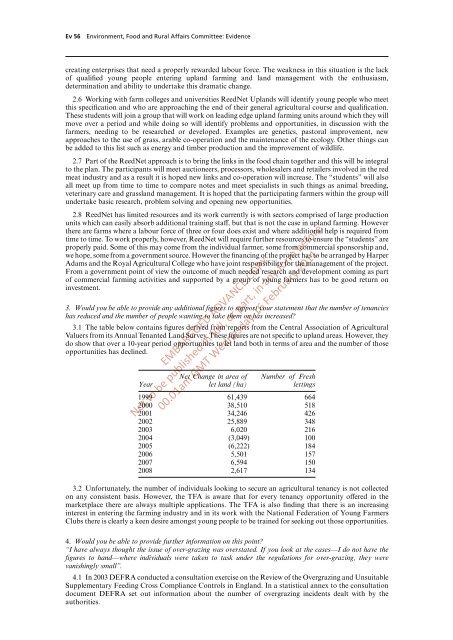Farming in the Uplands - ARCHIVE: Defra
Farming in the Uplands - ARCHIVE: Defra
Farming in the Uplands - ARCHIVE: Defra
You also want an ePaper? Increase the reach of your titles
YUMPU automatically turns print PDFs into web optimized ePapers that Google loves.
Ev 56 Environment, Food and Rural Affairs Committee: Evidence<br />
creat<strong>in</strong>g enterprises that need a properly rewarded labour force. The weakness <strong>in</strong> this situation is <strong>the</strong> lack<br />
of qualified young people enter<strong>in</strong>g upland farm<strong>in</strong>g and land management with <strong>the</strong> enthusiasm,<br />
determ<strong>in</strong>ation and ability to undertake this dramatic change.<br />
2.6 Work<strong>in</strong>g with farm colleges and universities ReedNet <strong>Uplands</strong> will identify young people who meet<br />
this specification and who are approach<strong>in</strong>g <strong>the</strong> end of <strong>the</strong>ir general agricultural course and qualification.<br />
These students will jo<strong>in</strong> a group that will work on lead<strong>in</strong>g edge upland farm<strong>in</strong>g units around which <strong>the</strong>y will<br />
move over a period and while do<strong>in</strong>g so will identify problems and opportunities, <strong>in</strong> discussion with <strong>the</strong><br />
farmers, need<strong>in</strong>g to be researched or developed. Examples are genetics, pastoral improvement, new<br />
approaches to <strong>the</strong> use of grass, arable co-operation and <strong>the</strong> ma<strong>in</strong>tenance of <strong>the</strong> ecology. O<strong>the</strong>r th<strong>in</strong>gs can<br />
be added to this list such as energy and timber production and <strong>the</strong> improvement of wildlife.<br />
2.7 Part of <strong>the</strong> ReedNet approach is to br<strong>in</strong>g <strong>the</strong> l<strong>in</strong>ks <strong>in</strong> <strong>the</strong> food cha<strong>in</strong> toge<strong>the</strong>r and this will be <strong>in</strong>tegral<br />
to <strong>the</strong> plan. The participants will meet auctioneers, processors, wholesalers and retailers <strong>in</strong>volved <strong>in</strong> <strong>the</strong> red<br />
meat <strong>in</strong>dustry and as a result it is hoped new l<strong>in</strong>ks and co-operation will <strong>in</strong>crease. The “students” will also<br />
all meet up from time to time to compare notes and meet specialists <strong>in</strong> such th<strong>in</strong>gs as animal breed<strong>in</strong>g,<br />
veter<strong>in</strong>ary care and grassland management. It is hoped that <strong>the</strong> participat<strong>in</strong>g farmers with<strong>in</strong> <strong>the</strong> group will<br />
undertake basic research, problem solv<strong>in</strong>g and open<strong>in</strong>g new opportunities.<br />
2.8 ReedNet has limited resources and its work currently is with sectors comprised of large production<br />
units which can easily absorb additional tra<strong>in</strong><strong>in</strong>g staV, but that is not <strong>the</strong> case <strong>in</strong> upland farm<strong>in</strong>g. However<br />
<strong>the</strong>re are farms where a labour force of three or four does exist and where additional help is required from<br />
time to time. To work properly, however, ReedNet will require fur<strong>the</strong>r resources to ensure <strong>the</strong> “students” are<br />
properly paid. Some of this may come from <strong>the</strong> <strong>in</strong>dividual farmer, some from commercial sponsorship and,<br />
we hope, some from a government source. However <strong>the</strong> f<strong>in</strong>anc<strong>in</strong>g of <strong>the</strong> project has to be arranged by Harper<br />
Adams and <strong>the</strong> Royal Agricultural College who have jo<strong>in</strong>t responsibility for <strong>the</strong> management of <strong>the</strong> project.<br />
From a government po<strong>in</strong>t of view <strong>the</strong> outcome of much needed research and development com<strong>in</strong>g as part<br />
of commercial farm<strong>in</strong>g activities and supported by a group of young farmers has to be good return on<br />
<strong>in</strong>vestment.<br />
3. Would you be able to provide any additional figures to support your statement that <strong>the</strong> number of tenancies<br />
has reduced and <strong>the</strong> number of people want<strong>in</strong>g to take <strong>the</strong>m on has <strong>in</strong>creased?<br />
3.1 The table below conta<strong>in</strong>s figures derived from reports from <strong>the</strong> Central Association of Agricultural<br />
Valuers from its Annual Tenanted Land Survey. These figures are not specific to upland areas. However, <strong>the</strong>y<br />
do show that over a 10-year period opportunities to let land both <strong>in</strong> terms of area and <strong>the</strong> number of those<br />
opportunities has decl<strong>in</strong>ed.<br />
Net Change <strong>in</strong> area of Number of Fresh<br />
Year let land (ha) lett<strong>in</strong>gs<br />
1999 61,439 664<br />
2000 38,510 518<br />
2001 34,246 426<br />
2002 25,889 348<br />
2003 6,020 216<br />
2004 (3,049) 100<br />
2005 (6,222) 184<br />
2006 5,501 157<br />
2007 6,594 150<br />
2008 2,617 134<br />
EMBARGOED ADVANCE COPY:<br />
Not to be published <strong>in</strong> full, or part, <strong>in</strong> any form before<br />
00.01am GMT Wednesday 16 February 2011<br />
3.2 Unfortunately, <strong>the</strong> number of <strong>in</strong>dividuals look<strong>in</strong>g to secure an agricultural tenancy is not collected<br />
on any consistent basis. However, <strong>the</strong> TFA is aware that for every tenancy opportunity oVered <strong>in</strong> <strong>the</strong><br />
marketplace <strong>the</strong>re are always multiple applications. The TFA is also f<strong>in</strong>d<strong>in</strong>g that <strong>the</strong>re is an <strong>in</strong>creas<strong>in</strong>g<br />
<strong>in</strong>terest <strong>in</strong> enter<strong>in</strong>g <strong>the</strong> farm<strong>in</strong>g <strong>in</strong>dustry and <strong>in</strong> its work with <strong>the</strong> National Federation of Young Farmers<br />
Clubs <strong>the</strong>re is clearly a keen desire amongst young people to be tra<strong>in</strong>ed for seek<strong>in</strong>g out those opportunities.<br />
4. Would you be able to provide fur<strong>the</strong>r <strong>in</strong>formation on this po<strong>in</strong>t?<br />
“I have always thought <strong>the</strong> issue of over-graz<strong>in</strong>g was overstated. If you look at <strong>the</strong> cases—I do not have <strong>the</strong><br />
figures to hand—where <strong>in</strong>dividuals were taken to task under <strong>the</strong> regulations for over-graz<strong>in</strong>g, <strong>the</strong>y were<br />
vanish<strong>in</strong>gly small”.<br />
4.1 In 2003 DEFRA conducted a consultation exercise on <strong>the</strong> Review of <strong>the</strong> Overgraz<strong>in</strong>g and Unsuitable<br />
Supplementary Feed<strong>in</strong>g Cross Compliance Controls <strong>in</strong> England. In a statistical annex to <strong>the</strong> consultation<br />
document DEFRA set out <strong>in</strong>formation about <strong>the</strong> number of overgraz<strong>in</strong>g <strong>in</strong>cidents dealt with by <strong>the</strong><br />
authorities.

















